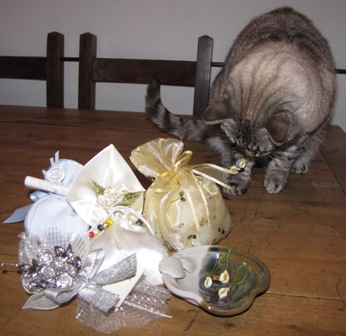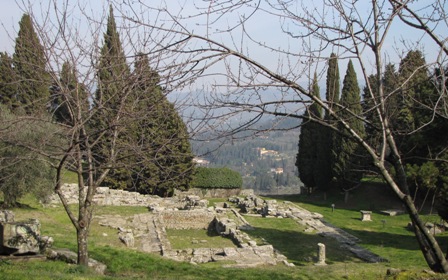Since I am a bit tired right now and don’t feel like doing any research or editing (zzz!), I am going to write about one of my students, a slender man, about my age, with an irresistible twinkle in his eye. Let’s call him Phil. I have been teaching Phil English for about a year and a half, now. Until this morning, though, I had NO idea how dangerous this meek-looking man could be. It turns out that he is an evil prankster. Here are just a few of the practical jokes he has played in the past on unsuspecting victims…
Phil’s “criminal” career began early, when he was but a child. For instance, Phil would fill his grandfather’s slippers with icky goo while the dear man took his afternoon nap. You can imagine what happened when, still half asleep, his grandfather slipped his feet into…yuuuck!
The adult Phil worked for several years in a leather company in Florence. One of his colleagues was a Ms. Perfect, a prim and proper lady who always wore THE perfect outfit, THE perfect makeup, THE perfect accessories. Never a hair out of place. Well, once, on a rainy day, Phil sprinkled an entire bottle of talcum powder inside her umbrella. After work, she grabbed the umbrella, went outside and opened it…right over her head, as it happened. POOF! A cloud of talcum powder covered her…from head to toe.
Another day Phil announced that he was about to get married. A few days later, he showed up at work carrying a wedding cake with a bride and groom on top and also some bomboniere. These are typical Italian wedding “favours,” which consist of five sugared almonds symbolizing health, wealth, happiness, fertility and long life. The almonds are usually placed inside small tulle or organza sachets together with some stupid little trinket.
The bomboniera tradition is still alive in Italy, although the useless, and expensive!, trinkets are being replaced, thank goodness!, by contributions to charitable organizations. But almonds are still offered to wedding guests.  Before Stefano and I got married, we spent HOURS putting together our bomboniere, counting the almonds, putting them inside the sachets, adding tiny fake flowers and trying to tie the tiny little ribbons…Can you tell that I believe that certain traditions should be abolished??? Except that some of the sachets that I have collected over the years (why on earth have I kept them???) and was attempting to photograph just now provided a certain amount of entertainment for Peekaboo, as you can see…by the way, our wedding “trinket,” a ceramic spoon rest made by a potter friend in the United States, can be seen in the foreground. We wanted it to be useful, at least.
Before Stefano and I got married, we spent HOURS putting together our bomboniere, counting the almonds, putting them inside the sachets, adding tiny fake flowers and trying to tie the tiny little ribbons…Can you tell that I believe that certain traditions should be abolished??? Except that some of the sachets that I have collected over the years (why on earth have I kept them???) and was attempting to photograph just now provided a certain amount of entertainment for Peekaboo, as you can see…by the way, our wedding “trinket,” a ceramic spoon rest made by a potter friend in the United States, can be seen in the foreground. We wanted it to be useful, at least.
At any rate, Phil did such a good job of tricking his colleagues into believing that he had gotten married that he was showered with wedding gifts for days. Hmmm, I forgot to ask if he returned them…
Another story. One of Phil’s colleagues kept a milk carton in the fridge for his morning caffelatte. One day, Phil carefully opened a brand new carton, finished off the milk and filled the empty carton with water. He then sealed it back up again. And waited…
The following story finally convinced me that Phil (I am quite fond of him, you see) has an evil streak. One day, Phil opened another colleague’s container of plain white yogurt. He ate or got rid of the yogurt, then filled the empty container with white glue and sealed it up again. After lunch, the unsuspecting colleague opened his yogurt, sniffed a spoonful and declared, “y’know, Phil, this yogurt really smells a bit ‘off.’” I forget exactly, but I think he may have tasted it just to be sure…
I have vowed never to let Phil within a few metres of the fruit juice that I take to work…
 Well, actually, it’s not an
Well, actually, it’s not an  been there since liceo (high school), so it was fun and new for both of us.
been there since liceo (high school), so it was fun and new for both of us.  The third photo offers a view of what is left of the Etruscan and Roman temples.
The third photo offers a view of what is left of the Etruscan and Roman temples. 